There are many different reasons why people come to Ocean City. For most, it’s the beaches and fun in the sun along with the cooler temperatures we generally have here at the shore. For others it is the boardwalk, the shops and all its attractions. But for some, just a stroll on the beach at sunrise or sunset is the solace that makes our town special. For what ever reason you may have, we invite you to come along as we explore the natural beaches and dunes of Corson’s Inlet State Park.
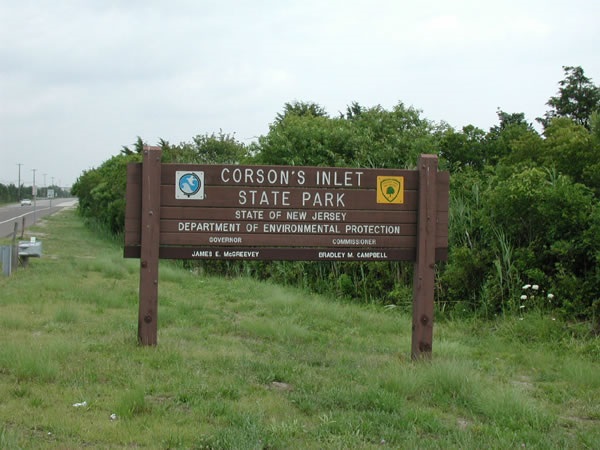 http://www.state.nj.us/dep/parksandforests/parks/corsons.html
http://www.state.nj.us/dep/parksandforests/parks/corsons.html
This evening begins at the main entrance to the park, along the causeway from 55
th Street in OC to Strathemere. (CMC Route 619 ) We chose low tide for this walk since Hurricane Sandy has eroded some of the beaches and moved the high water line landward. Access around the point is limited at high tide but during low tide, the gullies and sandbars are fully exposed. There is no entrance fee to the park and parking is free. During the days of the summer months, the State of NJ has an employee stationed there who can answer questions and tell of the natural history of the park. The state also maintains a “for fee” concrete boat ramp and has parking for boat trailers after launching. While there is a parking area, the availability in summer is sometimes limited, but over flow parking lines up in the grass along the side of the road near the entrance. The park can also be accessed from the Ocean City beach at 59
th St. and Central Avenue, where there is a city owned, metered, parking area.
Corson’s InletState Park brings to us the diversity between the coastal wetlands and the ocean front shoreline. With a total area of 341 acres, the park encompasses the entire southern tip of the island and offers outstanding sunrise and sunset views, fishing, bird watching and hiking trails, unobstructed by the modern development of today’s coast line.
Taking our binoculars and a bottle of water, and with a little bit of bug repellent on our feet, we set out to first explore the old railroad bed which once connected Ocean City to Sea Isle City and destinations south. This rail line owned by the Pennsylvania Reading Railroad and later by the West Jersey and Seashore line, provided transportation between the barrier islands and the Philadelphia area. Once on to the island, the WJ&S used tracks that ran the length of the island.
Looking back towards where we had entered the parking lot, and to an opening in the guard rail, we saw the entrance of the old rail road trail. We quickly noticed how vegetated this area has become. Large Red cedars and Bayberry, Sumac, poison Ivy, Virginia Creeper, Honeysuckle, along with other species now cover the place where steam locomotives once pulled passenger cars of excited tourists heading to the shore and beaches for the day. The trail was cut wide enough with the foot path down the center which offered us viewing of the coastal meadows to the west and a fairly large pond to the east. With our binoculars in hand, we spent some time watching the egrets and herons hunting small fish in the shallows. Completely intent on luring the small fish to them with their feet, they were unaware of our presence.
Turning our eyes toward the sky, we watched the Barn Swallows over the meadows dipping and gliding. A small bird, the swallow is built for flight maneuverability.
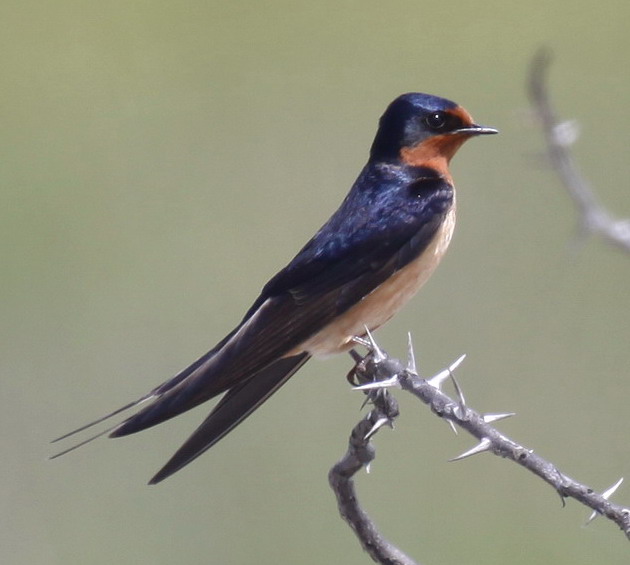
Barn Swallow
Feeding exclusively on insects, their acrobatics are truly remarkable, making turns and swoops that would seem to rival a fighter jet. Using their beak to capture insects on the wing, they solely depend on their abilities in flight to catch their dinner.
Next, our attention is drawn to a somewhat rare bird sighting for us among the many Red Cedar trees growing along the trail. The Cedar berries are ripening, turning blue and feeding on them were several Cedar Wax Wings.
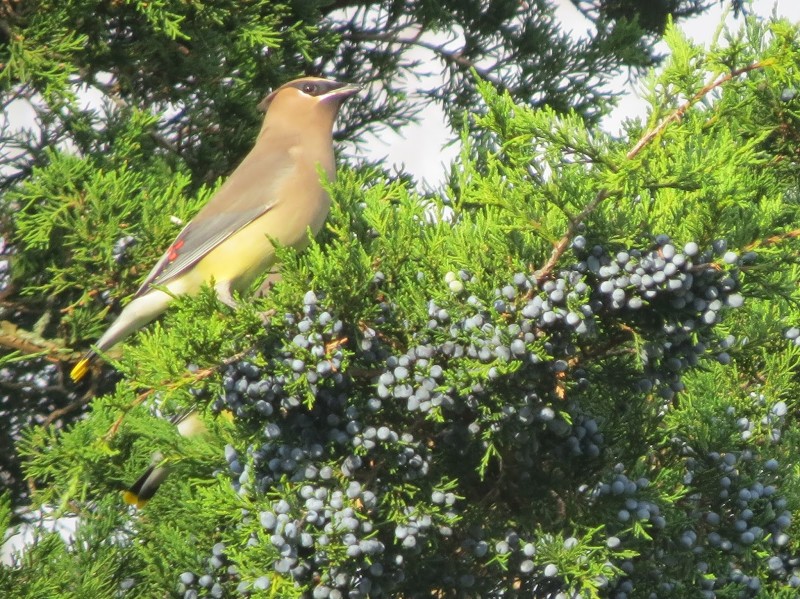
Cedar Wax Wing / Red Cedar with berries
The cedar berries are a favored diet for the Cedar Wax Wing and with binoculars and at a distance we were able to observe them feeding, undisturbed by our presence. As we made our way back out to the parking lot, I was reminded again of the history here, of the railroad and the wooden trestle of the original Rush Chattin Bridge and the many people that traveled by train to the shore to enjoy our beaches. At about 1/3 of a mile long out and back, this short and secluded walkway along the old train tracks was an easy walk and was completely enjoyable. In conclusion, Ocean City approved a plan in 2014 that may in the future connect the rail trail to 59 th Street. You can read more on these discussions in a previous article of ocnjdaily entitled, Ocean City lends support to Corson’s Inlet boardwalk.
Back out at the parking lot, we used the handicap ramp to cross the bridge on foot. The view from the pedestrian walkway of the Rush Chattin Bridge is remarkable. Above the height of the dunes, the ocean was visible to the east and a full view of the coastal meadows to the west. After spending a little while taking it all in, we headed for the beach, entering the sand dunes along the main path. Several signs are posted about the natural resources and wildlife habitats within the park at the entrance. There we stopped on a wooden foot bridge, where as a child some 45 years ago, I had memories of chasing minnows in the open creek below. That creek, which is now filled in with sand and grasses, was a favorite spot to play when I was young. Just past the bridge and along a path of white beach sand, is a fork in the trail. To the right leads directly to the back bay beach and inlet. Today we chose the left fork which leads you across the dunes to the ocean front. This short trail to the beach was at times tight as vegetation has grown close to the edge of the trails.
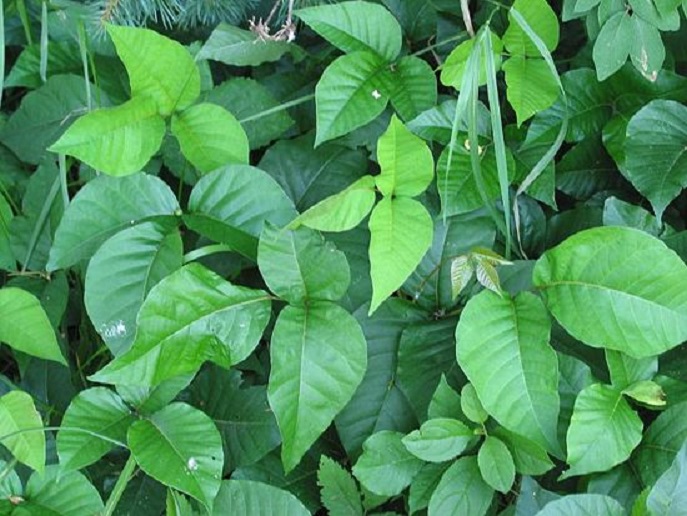
Poison Ivy
Poison Ivy is abundant along the trail and care should be taken to avoid brushing into it. If you are walking with young children, they should know how to identify the plant and should understand the importance of avoiding it. With that said and with some care to not touch the plant, it was a relatively easy walk. As we reached the ocean front we were taken back by the expansive beauty of the beach and dunes in their natural setting, undisturbed, without development. It was low tide and the receding water had left a long gully parallel to the waterline. Taking off our sandals, we walked south through the shallow gullies towards the point where more sand bars were exposed and shallow ponds laid trapped by the ever changing sand movements of the inlet. While walking along, the memories of my youth flooded back on me as I remembered the days when Dad and Mom would bring our family here with charcoal and burgers, as we played in the shallows of these gullies and ponds. With Strathemere and Sea Isle in view to the south and Ocean City and Atlantic City to the north, this is truly a place to experience the natural environment in between the modern day development of the coastline. Leaving the low tide and climbing the sloping beach to the high water line, we gazed across the area roped off for the habitat protection of our endangered beach nesting birds. Hoping to spot an endangered Piping Plover, Least Turn or Black Skimmer, we scanned the sand with our binoculars.
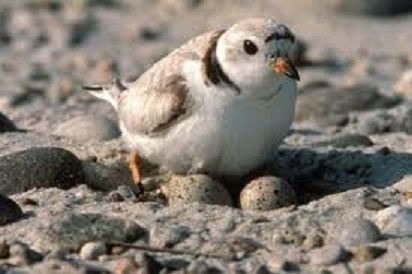
Piping Plover with eggs
The Plover, which lays eggs in only a small depression in the sand blends in perfectly and they are hard to spot unless they move about. Since 1993, The NJ Endangered and non-game Species Program has been selecting areas that are critical nesting habitat for these birds. The ropes and signs placed by the state mark the areas where access is restricted. You can read more on this endangered beach nesting bird and others at the NJ endangered species program website.
http://www.state.nj.us/dep/fgw/ensp/pdf/end-thrtened/plover.pdf
Using our binoculars, our attention soon turned to a common beach creature which is rarely seen. Not far ahead we spotted a Ghost crab foraging for insects. If you have visited the beach, you have most likely seen their telltale footprints leading to a small hole above the waterline. They are elusive and since they stay out of our way, they have probably retreated to their burrow before we know it, leaving us bewildered to what could have made the tracks. Ghost crabs dig a burrow which can be as deep as four feet and use it for protection in summer from gulls and other threats. In winter they hibernate in the burrow and emerge in spring to meet the ocean again.
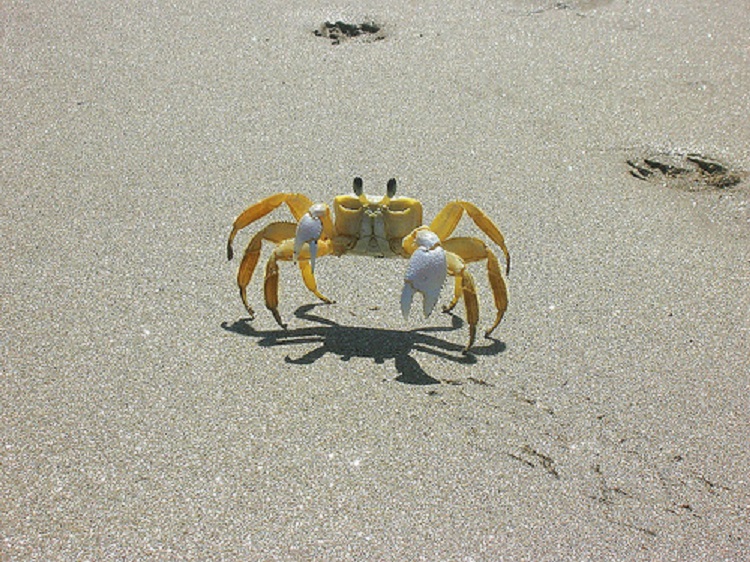
Atlantic Ghost Crab
Today we watched as a large ghost crab ran about the sand foraging for food, all the while keeping an eye on us as we slowly moved closer for a picture. This was truly a special sighting for us to be able to watch one so long and to be allowed to get so close. With the ability to turn their obvious black eyes in any direction, we watched as it watched us, being leery to not get too far from its burrow.
As the sun was setting we moved on around the point and to the waterway behind the peninsula. As you walk along with the vegetated dune rising above our heads on one side and the peaceful waters of Corson’s Inlet on the other, you could forget the ocean front is so close behind. The dune and vegetation blocked the sound of the surf and we found ourselves in awe of the evening as the sun set into the tree line of the mainland across the meadows. Although the sunset was captivating, it did not stop us from noticing the immense amount of sand and dune which makes up Corson’s Inlet State Park. This area, although ever changing due to the moving sand from wind and water currents is always a little different each time we visit. The sand bars change, the dunes erode and build, the tides rise and fall and the weather takes its toll, but all in all, Corson’s Inlet State Park remains intact and unchanged as one of the great natural attractions of Ocean City.
For my wife and I the three hours spent today was more than a walk on the beach. It was a nostalgia trip, a time to reminisce of the childhood days growing up in and around Ocean City. It was a time to get some sand back in our shoes, to be reminded of the rich history we have here, and to appreciate again this great resort town of our youth.
Thank you for coming along, we hope to see you out there in the sand.
Paul
Editor’s note:
Paul and His wife are life long residents of the area and have spent much of their lives together exploring the natural areas of our southern New Jersey region. With a specialty in bird identification, migration patterns and nesting habits as well as numerous raptor programs and wildlife projects, they have spoken to thousands of residents and visitors about the valuable natural resources we have here in Southern New Jersey.
 http://www.state.nj.us/dep/parksandforests/parks/corsons.html
This evening begins at the main entrance to the park, along the causeway from 55th Street in OC to Strathemere. (CMC Route 619 ) We chose low tide for this walk since Hurricane Sandy has eroded some of the beaches and moved the high water line landward. Access around the point is limited at high tide but during low tide, the gullies and sandbars are fully exposed. There is no entrance fee to the park and parking is free. During the days of the summer months, the State of NJ has an employee stationed there who can answer questions and tell of the natural history of the park. The state also maintains a “for fee” concrete boat ramp and has parking for boat trailers after launching. While there is a parking area, the availability in summer is sometimes limited, but over flow parking lines up in the grass along the side of the road near the entrance. The park can also be accessed from the Ocean City beach at 59th St. and Central Avenue, where there is a city owned, metered, parking area.
Corson’s InletState Park brings to us the diversity between the coastal wetlands and the ocean front shoreline. With a total area of 341 acres, the park encompasses the entire southern tip of the island and offers outstanding sunrise and sunset views, fishing, bird watching and hiking trails, unobstructed by the modern development of today’s coast line.
Taking our binoculars and a bottle of water, and with a little bit of bug repellent on our feet, we set out to first explore the old railroad bed which once connected Ocean City to Sea Isle City and destinations south. This rail line owned by the Pennsylvania Reading Railroad and later by the West Jersey and Seashore line, provided transportation between the barrier islands and the Philadelphia area. Once on to the island, the WJ&S used tracks that ran the length of the island.
Looking back towards where we had entered the parking lot, and to an opening in the guard rail, we saw the entrance of the old rail road trail. We quickly noticed how vegetated this area has become. Large Red cedars and Bayberry, Sumac, poison Ivy, Virginia Creeper, Honeysuckle, along with other species now cover the place where steam locomotives once pulled passenger cars of excited tourists heading to the shore and beaches for the day. The trail was cut wide enough with the foot path down the center which offered us viewing of the coastal meadows to the west and a fairly large pond to the east. With our binoculars in hand, we spent some time watching the egrets and herons hunting small fish in the shallows. Completely intent on luring the small fish to them with their feet, they were unaware of our presence.
Turning our eyes toward the sky, we watched the Barn Swallows over the meadows dipping and gliding. A small bird, the swallow is built for flight maneuverability.
http://www.state.nj.us/dep/parksandforests/parks/corsons.html
This evening begins at the main entrance to the park, along the causeway from 55th Street in OC to Strathemere. (CMC Route 619 ) We chose low tide for this walk since Hurricane Sandy has eroded some of the beaches and moved the high water line landward. Access around the point is limited at high tide but during low tide, the gullies and sandbars are fully exposed. There is no entrance fee to the park and parking is free. During the days of the summer months, the State of NJ has an employee stationed there who can answer questions and tell of the natural history of the park. The state also maintains a “for fee” concrete boat ramp and has parking for boat trailers after launching. While there is a parking area, the availability in summer is sometimes limited, but over flow parking lines up in the grass along the side of the road near the entrance. The park can also be accessed from the Ocean City beach at 59th St. and Central Avenue, where there is a city owned, metered, parking area.
Corson’s InletState Park brings to us the diversity between the coastal wetlands and the ocean front shoreline. With a total area of 341 acres, the park encompasses the entire southern tip of the island and offers outstanding sunrise and sunset views, fishing, bird watching and hiking trails, unobstructed by the modern development of today’s coast line.
Taking our binoculars and a bottle of water, and with a little bit of bug repellent on our feet, we set out to first explore the old railroad bed which once connected Ocean City to Sea Isle City and destinations south. This rail line owned by the Pennsylvania Reading Railroad and later by the West Jersey and Seashore line, provided transportation between the barrier islands and the Philadelphia area. Once on to the island, the WJ&S used tracks that ran the length of the island.
Looking back towards where we had entered the parking lot, and to an opening in the guard rail, we saw the entrance of the old rail road trail. We quickly noticed how vegetated this area has become. Large Red cedars and Bayberry, Sumac, poison Ivy, Virginia Creeper, Honeysuckle, along with other species now cover the place where steam locomotives once pulled passenger cars of excited tourists heading to the shore and beaches for the day. The trail was cut wide enough with the foot path down the center which offered us viewing of the coastal meadows to the west and a fairly large pond to the east. With our binoculars in hand, we spent some time watching the egrets and herons hunting small fish in the shallows. Completely intent on luring the small fish to them with their feet, they were unaware of our presence.
Turning our eyes toward the sky, we watched the Barn Swallows over the meadows dipping and gliding. A small bird, the swallow is built for flight maneuverability.

 Cedar Wax Wing / Red Cedar with berries
The cedar berries are a favored diet for the Cedar Wax Wing and with binoculars and at a distance we were able to observe them feeding, undisturbed by our presence. As we made our way back out to the parking lot, I was reminded again of the history here, of the railroad and the wooden trestle of the original Rush Chattin Bridge and the many people that traveled by train to the shore to enjoy our beaches. At about 1/3 of a mile long out and back, this short and secluded walkway along the old train tracks was an easy walk and was completely enjoyable. In conclusion, Ocean City approved a plan in 2014 that may in the future connect the rail trail to 59 th Street. You can read more on these discussions in a previous article of ocnjdaily entitled, Ocean City lends support to Corson’s Inlet boardwalk.
Back out at the parking lot, we used the handicap ramp to cross the bridge on foot. The view from the pedestrian walkway of the Rush Chattin Bridge is remarkable. Above the height of the dunes, the ocean was visible to the east and a full view of the coastal meadows to the west. After spending a little while taking it all in, we headed for the beach, entering the sand dunes along the main path. Several signs are posted about the natural resources and wildlife habitats within the park at the entrance. There we stopped on a wooden foot bridge, where as a child some 45 years ago, I had memories of chasing minnows in the open creek below. That creek, which is now filled in with sand and grasses, was a favorite spot to play when I was young. Just past the bridge and along a path of white beach sand, is a fork in the trail. To the right leads directly to the back bay beach and inlet. Today we chose the left fork which leads you across the dunes to the ocean front. This short trail to the beach was at times tight as vegetation has grown close to the edge of the trails.
Cedar Wax Wing / Red Cedar with berries
The cedar berries are a favored diet for the Cedar Wax Wing and with binoculars and at a distance we were able to observe them feeding, undisturbed by our presence. As we made our way back out to the parking lot, I was reminded again of the history here, of the railroad and the wooden trestle of the original Rush Chattin Bridge and the many people that traveled by train to the shore to enjoy our beaches. At about 1/3 of a mile long out and back, this short and secluded walkway along the old train tracks was an easy walk and was completely enjoyable. In conclusion, Ocean City approved a plan in 2014 that may in the future connect the rail trail to 59 th Street. You can read more on these discussions in a previous article of ocnjdaily entitled, Ocean City lends support to Corson’s Inlet boardwalk.
Back out at the parking lot, we used the handicap ramp to cross the bridge on foot. The view from the pedestrian walkway of the Rush Chattin Bridge is remarkable. Above the height of the dunes, the ocean was visible to the east and a full view of the coastal meadows to the west. After spending a little while taking it all in, we headed for the beach, entering the sand dunes along the main path. Several signs are posted about the natural resources and wildlife habitats within the park at the entrance. There we stopped on a wooden foot bridge, where as a child some 45 years ago, I had memories of chasing minnows in the open creek below. That creek, which is now filled in with sand and grasses, was a favorite spot to play when I was young. Just past the bridge and along a path of white beach sand, is a fork in the trail. To the right leads directly to the back bay beach and inlet. Today we chose the left fork which leads you across the dunes to the ocean front. This short trail to the beach was at times tight as vegetation has grown close to the edge of the trails.
 Poison Ivy
Poison Ivy is abundant along the trail and care should be taken to avoid brushing into it. If you are walking with young children, they should know how to identify the plant and should understand the importance of avoiding it. With that said and with some care to not touch the plant, it was a relatively easy walk. As we reached the ocean front we were taken back by the expansive beauty of the beach and dunes in their natural setting, undisturbed, without development. It was low tide and the receding water had left a long gully parallel to the waterline. Taking off our sandals, we walked south through the shallow gullies towards the point where more sand bars were exposed and shallow ponds laid trapped by the ever changing sand movements of the inlet. While walking along, the memories of my youth flooded back on me as I remembered the days when Dad and Mom would bring our family here with charcoal and burgers, as we played in the shallows of these gullies and ponds. With Strathemere and Sea Isle in view to the south and Ocean City and Atlantic City to the north, this is truly a place to experience the natural environment in between the modern day development of the coastline. Leaving the low tide and climbing the sloping beach to the high water line, we gazed across the area roped off for the habitat protection of our endangered beach nesting birds. Hoping to spot an endangered Piping Plover, Least Turn or Black Skimmer, we scanned the sand with our binoculars.
Poison Ivy
Poison Ivy is abundant along the trail and care should be taken to avoid brushing into it. If you are walking with young children, they should know how to identify the plant and should understand the importance of avoiding it. With that said and with some care to not touch the plant, it was a relatively easy walk. As we reached the ocean front we were taken back by the expansive beauty of the beach and dunes in their natural setting, undisturbed, without development. It was low tide and the receding water had left a long gully parallel to the waterline. Taking off our sandals, we walked south through the shallow gullies towards the point where more sand bars were exposed and shallow ponds laid trapped by the ever changing sand movements of the inlet. While walking along, the memories of my youth flooded back on me as I remembered the days when Dad and Mom would bring our family here with charcoal and burgers, as we played in the shallows of these gullies and ponds. With Strathemere and Sea Isle in view to the south and Ocean City and Atlantic City to the north, this is truly a place to experience the natural environment in between the modern day development of the coastline. Leaving the low tide and climbing the sloping beach to the high water line, we gazed across the area roped off for the habitat protection of our endangered beach nesting birds. Hoping to spot an endangered Piping Plover, Least Turn or Black Skimmer, we scanned the sand with our binoculars.
 Piping Plover with eggs
The Plover, which lays eggs in only a small depression in the sand blends in perfectly and they are hard to spot unless they move about. Since 1993, The NJ Endangered and non-game Species Program has been selecting areas that are critical nesting habitat for these birds. The ropes and signs placed by the state mark the areas where access is restricted. You can read more on this endangered beach nesting bird and others at the NJ endangered species program website. http://www.state.nj.us/dep/fgw/ensp/pdf/end-thrtened/plover.pdf
Using our binoculars, our attention soon turned to a common beach creature which is rarely seen. Not far ahead we spotted a Ghost crab foraging for insects. If you have visited the beach, you have most likely seen their telltale footprints leading to a small hole above the waterline. They are elusive and since they stay out of our way, they have probably retreated to their burrow before we know it, leaving us bewildered to what could have made the tracks. Ghost crabs dig a burrow which can be as deep as four feet and use it for protection in summer from gulls and other threats. In winter they hibernate in the burrow and emerge in spring to meet the ocean again.
Piping Plover with eggs
The Plover, which lays eggs in only a small depression in the sand blends in perfectly and they are hard to spot unless they move about. Since 1993, The NJ Endangered and non-game Species Program has been selecting areas that are critical nesting habitat for these birds. The ropes and signs placed by the state mark the areas where access is restricted. You can read more on this endangered beach nesting bird and others at the NJ endangered species program website. http://www.state.nj.us/dep/fgw/ensp/pdf/end-thrtened/plover.pdf
Using our binoculars, our attention soon turned to a common beach creature which is rarely seen. Not far ahead we spotted a Ghost crab foraging for insects. If you have visited the beach, you have most likely seen their telltale footprints leading to a small hole above the waterline. They are elusive and since they stay out of our way, they have probably retreated to their burrow before we know it, leaving us bewildered to what could have made the tracks. Ghost crabs dig a burrow which can be as deep as four feet and use it for protection in summer from gulls and other threats. In winter they hibernate in the burrow and emerge in spring to meet the ocean again.
 Atlantic Ghost Crab
Today we watched as a large ghost crab ran about the sand foraging for food, all the while keeping an eye on us as we slowly moved closer for a picture. This was truly a special sighting for us to be able to watch one so long and to be allowed to get so close. With the ability to turn their obvious black eyes in any direction, we watched as it watched us, being leery to not get too far from its burrow.
As the sun was setting we moved on around the point and to the waterway behind the peninsula. As you walk along with the vegetated dune rising above our heads on one side and the peaceful waters of Corson’s Inlet on the other, you could forget the ocean front is so close behind. The dune and vegetation blocked the sound of the surf and we found ourselves in awe of the evening as the sun set into the tree line of the mainland across the meadows. Although the sunset was captivating, it did not stop us from noticing the immense amount of sand and dune which makes up Corson’s Inlet State Park. This area, although ever changing due to the moving sand from wind and water currents is always a little different each time we visit. The sand bars change, the dunes erode and build, the tides rise and fall and the weather takes its toll, but all in all, Corson’s Inlet State Park remains intact and unchanged as one of the great natural attractions of Ocean City.
For my wife and I the three hours spent today was more than a walk on the beach. It was a nostalgia trip, a time to reminisce of the childhood days growing up in and around Ocean City. It was a time to get some sand back in our shoes, to be reminded of the rich history we have here, and to appreciate again this great resort town of our youth.
Thank you for coming along, we hope to see you out there in the sand.
Paul
Editor’s note:
Paul and His wife are life long residents of the area and have spent much of their lives together exploring the natural areas of our southern New Jersey region. With a specialty in bird identification, migration patterns and nesting habits as well as numerous raptor programs and wildlife projects, they have spoken to thousands of residents and visitors about the valuable natural resources we have here in Southern New Jersey.
Atlantic Ghost Crab
Today we watched as a large ghost crab ran about the sand foraging for food, all the while keeping an eye on us as we slowly moved closer for a picture. This was truly a special sighting for us to be able to watch one so long and to be allowed to get so close. With the ability to turn their obvious black eyes in any direction, we watched as it watched us, being leery to not get too far from its burrow.
As the sun was setting we moved on around the point and to the waterway behind the peninsula. As you walk along with the vegetated dune rising above our heads on one side and the peaceful waters of Corson’s Inlet on the other, you could forget the ocean front is so close behind. The dune and vegetation blocked the sound of the surf and we found ourselves in awe of the evening as the sun set into the tree line of the mainland across the meadows. Although the sunset was captivating, it did not stop us from noticing the immense amount of sand and dune which makes up Corson’s Inlet State Park. This area, although ever changing due to the moving sand from wind and water currents is always a little different each time we visit. The sand bars change, the dunes erode and build, the tides rise and fall and the weather takes its toll, but all in all, Corson’s Inlet State Park remains intact and unchanged as one of the great natural attractions of Ocean City.
For my wife and I the three hours spent today was more than a walk on the beach. It was a nostalgia trip, a time to reminisce of the childhood days growing up in and around Ocean City. It was a time to get some sand back in our shoes, to be reminded of the rich history we have here, and to appreciate again this great resort town of our youth.
Thank you for coming along, we hope to see you out there in the sand.
Paul
Editor’s note:
Paul and His wife are life long residents of the area and have spent much of their lives together exploring the natural areas of our southern New Jersey region. With a specialty in bird identification, migration patterns and nesting habits as well as numerous raptor programs and wildlife projects, they have spoken to thousands of residents and visitors about the valuable natural resources we have here in Southern New Jersey.